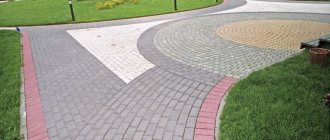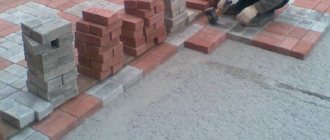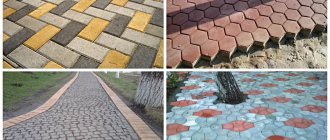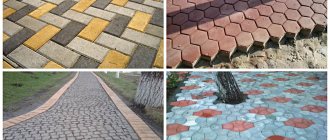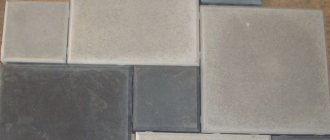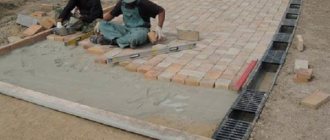Reasons for the destruction of the sidewalk path
The main reason for the destruction of a sidewalk path is frost heaving of the soil under the patty or heaving of the sand cushion under the tiles. The thing is that no matter how low the air temperature is, the soil always remains “warmer” and, naturally, this leads to the formation of condensation, which, rising to the surface, destroys the pavement covering. That is, moisture freezes at the surface and tends to expand along with the coating.
Therefore, the main function of the composition of the base under the tile (pie) is to drain condensate back into the soil. The best option for removing moisture is gravel of various fractions, which has high capillarity. What about sand, why is it needed? Many people believe that sand also serves to drain condensate, but this is a mistaken opinion. Yes, water passes through sand, but due to its low capillarity, the process takes a long time and during this time the moisture turns into deep ice. The only role of sand in the pie is that it is convenient to lay paving slabs on it. That's all!
Another reason for the destruction of the sidewalk covering is poorly compacted soil onto which the components of the pie are poured. This must always be remembered: the soil, its composition, as well as compaction are the determining factors that influence the quality of the finish surface of the path.
Concreting
This is one of the most common and inexpensive options for installing garden paths. Concrete can be easily shaped into the desired shape. Therefore, it will be possible to make paths with turns, arrange small areas and other shapes.
To concrete the paths, you will also need a 30 cm deepening of the soil. It must be laid with insulation and sand bedding made, as recommended above. Concrete mortar can be ordered ready-made or you can prepare it yourself. Read how to concrete at low temperatures here.
The main thing is to accurately calculate your strengths and capabilities. Since the concrete layer will be about 20 cm deep, and the width of the path will be 1 meter, then 5 linear meters will take 1 cubic meter of concrete.
Using this calculation as a basis, you can easily calculate the volume of concrete mixture required to create paths. For example, with a total length of 20 meters, at least 4 cubes of concrete will be required. This is a lot and amounts to the volume of one “mixer”, that is, a machine that transports the solution and delivers it from the hose.
But ordering a car and receiving concrete will cost a lot of money. To save money, you can prepare the solution yourself. To avoid tedious manual mixing of the solution, you should rent a mobile concrete mixer.
This device will allow you to knead 4 cubes of solution in one day. In this case, it is necessary to purchase cement, crushed stone and sand. These ingredients are poured into a concrete mixer. And the finished solution is taken and poured into the boundaries of the paths. To prevent it from leaking out, it is necessary to make formwork. The method of constructing the formwork is described above. It is based on the use of unedged boards, slate or moisture-resistant plywood.
Popular articles Edible flowers: 5 most delicious flowers and tips for consumption
Pie on normal soils
If you are going to lay a sidewalk path on normal soil, that is, in your area the groundwater is deep, the top layer of soil consists mainly of chernozem, then the composition of the pie is as follows:
- Gravel of fractions 10–15 with a layer thickness of 10–15 cm.
- Fine-grained sand 10 cm thick.
You can limit yourself to this, but if large gravel is laid (fractions 20–30), then you will need to lay geotextiles between the sand and gravel so that the sand does not go into the gravel.
Advantages and disadvantages of different tracks
Each type of path covering has its own disadvantages and advantages, which should be taken into account when arranging a personal plot.
Rubber garden paths
In the simplest case (conveyor belt) this is the cheapest track option. However, the conveyor belt has a significant drawback: when wet, its surface becomes slippery. However, today some enterprises produce special roll tracks from rubber - a product of recycling old car tires. This material has an anti-slip surface.
Concrete garden paths
This option is considered the most durable. After all, concrete is resistant to atmospheric influences, mechanical and abrasive influences. At the same time, it can look beautiful and aesthetically pleasing. After all, it doesn’t have to be a solid gray screed. Tiles for garden paths can be very diverse. In addition, special stencils are available for sale into which you can pour concrete yourself. If you wish, you can make them yourself, using available materials. Moreover, if the filling is carried out in the cold season, then it is necessary to use special additives to impart elasticity - plasticizers.
Garden paths made of wood
They are quite popular among those summer residents who strive to reunite with nature and return to their roots. The main problem with such tracks is the relatively short service life of the material. The main advantage is accessibility and low cost. Very often, because of their cheapness and practicality, garden paths made of boards are arranged in vegetable gardens between the beds.
How to make a path from wood cuts One of the most interesting options for a DIY garden path.
Garden paths made of stone or sandstone flagstone
They look very stylish. They provide scope for creativity, as the material is very diverse. Durable. But the disadvantage of smooth natural stone is that it is slippery when wet. In addition, such material is not cheap. Of course, you can collect it in natural conditions, but in most cases the law prohibits this and imposes large fines for the destruction of the natural landscape. Therefore, for those who want to make cheap garden paths on their site, this option is not suitable.
Brick paths
Garden paths are often laid from old bricks. In this case, white (silicate) brick is not used. The advantage of this material is its availability, low cost and ease of processing (the excess can simply be beaten off with a hammer). Brick is not only red, but also yellow. This allows you to make something like a mosaic. You can lay it either simply on sand or on a solution.
The covering for garden paths is often made of coarse sand, small pebbles and even shells. Other bulk materials can also be used. Such options fit perfectly into any landscape, do not slip, as they allow water to pass through well, and, most importantly, are quite simple to implement. The disadvantage is the need to periodically level the coating, as well as add material that is carried by the wind or during operation.
Grass paths for the garden
Grass-covered garden paths deserve special attention. This design move looks impressive in the appropriate landscape, but has some peculiarities. The main one is the need to use special grass for sports turf. It has good resistance to various loads.
When installing such a path in your garden plot, you can either sow the grass yourself or buy a ready-made rolled lawn. In any case, you will need to follow the rules for establishing a lawn and caring for it. The disadvantage of this option is its low suitability for walking after heavy rainfall, as well as the need for periodic mowing and watering.
Popular articles Description and cultivation of Hydrangea paniculata Polistar
Using scrap materials (boards, old bricks, etc.) allows you to create an inexpensive garden path that embodies interesting design solutions.
Foundation on clay soils
Clay soil is distinguished by the fact that it has very low capillarity - it does not allow water to pass through well. Based on this, the composition of the cake should be such as to limit the flow of moisture into the clay as much as possible. The composition of the base can be as follows:
- The bottom is compacted clay.
- Then comes a layer of gravel.
- Layer of sand.
- The top layer of the cake is a prawn with a metal mesh.
If anyone doesn’t know what prancing is, let us explain. Gartsovka is a dry mixture of cement and sand, which turns into concrete at the first rain. And one more thing you need to take into account: in order for less moisture to get into the clay, the form of laying paving slabs should have a curvature on both sides so that water drains from the path.
Technology for laying paving slabs
There are three ways to lay paving stones:
Technology for laying paving stones on a sandy base
Regardless of what the paving stones will be laid on, the base cushion is always made of crushed stone or sand. After compacting the soil, spray it with water from a hose and repeat the process. Then pour a layer of sand 5-15 cm thick into the bed.
Pie composition on soft soils
On soils that are oversaturated with moisture, on loam (a lot of clay and sand), sandy loam (a lot of sand), the composition of the cake for laying paving slabs should not only retain moisture, but also prevent the entire path from sagging. After all, at its core, the base itself for the tiles is a long beam, which under load can bend, sinking into soft soil. This can be avoided by laying geotextiles on the ground before the cake layer.
It must be remembered that geotextiles not only have filtering ability, but have sufficient tensile strength that will keep the entire layer of the cake from sagging.
The composition of the cake for weak soils looks like this:
- Geotextiles are laid at the bottom of the ditch.
- Then gravel.
- Layer of sand.
- Concrete base.
DIY stone path
Garden paths made of stone or paving stones are, firstly, very aesthetically pleasing. Secondly, such a path can withstand heavy loads and can serve you for a very long time. The disadvantage is that a stone garden path will not be cheap (unless, of course, you have a supply of boulders on your site). One more point: there must be a drainage layer in the trench, otherwise the path will flood.
Paving stones (paving slabs)
A garden path made of paving slabs (paving stones) is an excellent option for those who prioritize practicality and reliability. A path made of paving slabs is not at all “boring”, as it might seem at first glance. You can use tiles of different shades, and also lay them in a non-standard pattern: herringbone, circle-shaped, checkerboard, etc. By the way, you can make paving stones with your own hands:
10 mistakes when making paving slabs with your own hands. Read for everyone! When making paving slabs with their own hands, novice craftsmen are in for a variety of different and not always pleasant surprises.
To make garden paths from paving stones, geotextiles are used: 1 layer of fabric is placed at the bottom of the trench, then coarse gravel is poured out and everything is covered with the material again. After this, the “bed” is covered with wet sand and the laying of paving stones begins. Instead of paving slabs, you can use brick.
Stone steps
Few materials can compare in durability, strength and at the same time decorativeness with natural stone. If you are the owner of a plot with a slope, then a stone staircase in the garden is what you need. You can decorate your garden with stairs using other materials:
Popular articles Hydrangea paniculata (Pink Lady): description, planting and flower care
Stairs in garden design: original ideas for steps (30 photos) An interesting selection of garden steps for an uneven landscape. Take note.
First you need to decide on the height of the steps and the size of the flagstone. Place each stone slab on a previously prepared “cushion” (a mixture of sand and crushed stone), fixing the step with cement mortar. To strengthen the stairs, build a retaining wall.
If you want the steps to be framed by grass in the future, then fill the gaps between the stones with sand.
Flagstone
An excellent material for garden paths. Due to the natural shape and color, flagstone (sandstone) goes well with the greenery of the garden. Such garden paths (see photo) look especially good in sunny places in a suburban area.
6 secrets of a picturesque garden path Winding, secluded, alluring - a path in the garden simply must be beautiful!
Use slabs of different sizes, laying them on cement mortar. The spaces between the slabs can be filled with fine gravel.
Mulch and stone
One of the easiest ways to make a garden path in your country house. Dig a shallow trench (as for the above-mentioned gravel paths), add a mixture of clay and coarse gravel to the bottom, then add sand. Each layer must be wetted and compacted. Then lay the stone slabs in random order, and fill the remaining space with mulching material: sawdust, pine bark, etc.
Everything you need to know about mulch, its types and effects. Caution: not all types of mulch are created equal!
Cobblestone
To recreate the atmosphere of an ancient garden, create a garden path paved with cobblestones. To do this you will need quite a lot (depending on the scale of the path) of stones. The more they differ from each other in color and size, the better. Laying stones is no different from laying paving stones and other similar materials: a concrete mixture is placed in the prepared trench, on which the stones are laid.
Paths made of gravel, crushed stone and pebbles
The so-called “bulk” paths made of fine material are cheap, will last a long time and have good drainage properties, which will only benefit the site. But there is also a significant drawback: small pebbles will eventually begin to move as you walk and move outside the path if you do not install a curb and periodically level the surface. In addition, such paths are not suitable for regular heavy loads.
To construct such a path, a shallow trench is traditionally dug, and the material itself is simply poured on top of a well-compacted and moistened cushion of sand or clay with crushed stone.
Also, an ordinary embankment path can be significantly strengthened and decorated with paving stones, boards, paving slabs, etc. If you are a perfectionist, you can even lay out different patterns on the path using pebbles of different colors and sizes (again, for durability, be sure to take care of stops and a binder like glue or cement).
- 16 ideas on what you can use to make a beautiful and practical garden path
A large selection of interesting and simple options for garden paths.
Brick paths
Both solid and broken bricks can serve as material for garden paths - they just need to be laid, deepened, on a surface strewn with sand. You can lay it tightly, or you can lay it with gaps, then filling them with the same sand, pebbles, gravel, etc. Some also place an additional layer of gravel or geotextile under the sand, others fasten the bricks with mortar or special glue, and others do not fill the gaps between the pieces of brick, preferring that grass then break through them.
What determines the durability of a brick walkway? From so many factors. This is the type of brick itself (the most durable, wear-resistant, moisture- and heat-resistant - clinker), and on the technology and density of laying, and on the thickness of the pads and the degree of compaction of sand and gravel (if any), and on the presence of a binding solution between bricks and a reinforcing layer of reinforcement on the sides of the path, and from using a primer with a special varnish on top of the material. As you can see, there really are a lot of nuances. In addition, most likely from time to time you will also have to level the coating.
- What can be made from unnecessary bricks at the dacha: 10 useful ideas
You are left with a large mountain of bricks from the construction of your dacha. We tell you where to “place” it, literally and figuratively.
